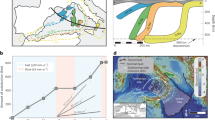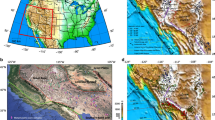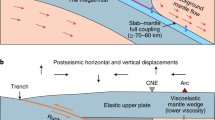Abstract
Mantle exhumation at slow-spreading ridges is favoured by extensional tectonics through low-angle detachment faults1,2,3,4, and, along transforms, by transtension due to changes in ridge/transform geometry5,6. Less common, exhumation by compressive stresses has been proposed for the large-offset transforms of the equatorial Atlantic7,8. Here we show, using high-resolution bathymetry, seismic and gravity data, that the northern transform fault of the St Paul system has been controlled by compressive deformation since ∼10 million years ago. The long-lived transpression resulted from ridge overlap due to the propagation of the northern Mid-Atlantic Ridge segment into the transform domain, which induced the migration and segmentation of the transform fault creating restraining stepovers. An anticlockwise change in plate motion at ∼11 million years ago5 initially favoured extension in the left-stepping transform, triggering the formation of a transverse ridge, later uplifted through transpression, forming the St Peter and St Paul islets. Enhanced melt supply at the ridge axis due to the nearby Sierra Leone thermo chemical anomaly9 is responsible for the robust response of the northern Mid-Atlantic Ridge segment to the kinematic change. The long-lived process at the origin of the compressive stresses is directly linked to the nature of the underlying mantle and not to a change in the far-field stress regime.
This is a preview of subscription content, access via your institution
Access options
Subscribe to this journal
Receive 12 print issues and online access
$259.00 per year
only $21.58 per issue
Buy this article
- Purchase on Springer Link
- Instant access to full article PDF
Prices may be subject to local taxes which are calculated during checkout





Similar content being viewed by others
References
Dick, H. J. B., Lin, J. & Schouten, H. An ultra slow spreading class of ocean ridge. Nature 426, 405–412 (2003).
Sauter, D. et al. Continuous exhumation of mantle-derived rocks at the Southwest Indian Ridge for 11 million years. Nature Geosci. 6, 314–320 (2013).
Escartín, J. et al. Central role of detachment faults in accretion of slow-spreading oceanic lithosphere. Nature 455, 790–794 (2008).
Smith, D. K., Escartin, J., Schouten, H. & Cann, J. R. Fault rotation and core complex formation: significant processes in seafloor formation at slow-spreading midocean ridges (Mid-Atlantic Ridge, 13–15° N). Geochem. Geophys. Geosyst. 9, Q03003 (2008).
Bonatti, E. et al. Flexural uplift of a lithospheric slab near the Vema transform (Central Atlantic): timing and mechanisms. Earth Planet. Sci. Lett. 240, 642–655 (2005).
Tucholke, B. E. & Schouten, H. Kane fracture zone. Mar. Geophys. Res. 10, 1–39 (1988).
Bonatti, E. et al. Transform migration and vertical tectonics at the Romanche fracture zone, Equatorial Atlantic. J. Geophys. Res. 99, 21779–21802 (1994).
Palmiotto, C. et al. Nonvolcanic tectonic islands in ancient and modern oceans. Geochem. Geophys. Geosyst. 14, 4698–4717 (2013).
Schilling, J.-G., Hanan, B. B., McCully, B., Kingsley, D. & Fontignie, D. Influence of the Sierra Leone mantle plume on the equatorial Mid-Atlantic Ridge: a Nd-Sr-Pb isotopic study. J. Geophys. Res. 99, 12005–12028 (1994).
Darwin, C. Geological Observations on the Volcanic Islands and Parts of South America Visited During the Voyage of H.M.S. ‘Beagle’ 3rd edn (Smith, Elder, 1891).
Melson, W. G., Jarosewich, E., Bowen, V. T. & Thompson, G. St. Peter and St. Paul Rocks: a high-temperature, mantle-derived intrusion. Science 155, 1532–1535 (1967).
Campos, T. F. C., Bezerra, F. H. R., Srivastava, N. K., Vieira, M. M. & Vita-Finzi, C. Holocene tectonic uplift of the St Peter and St Paul Rocks (Equatorial Atlantic) consistent with emplacement by extrusion. Mar. Geol. 271, 177–186 (2010).
Hekinian, R. et al. Submersible observations of Equatorial Atlantic mantle: the St Paul Fracture Zone region. Mar. Geophys. Res. 21, 529–560 (2000).
Schilling, J. G. et al. Thermal structure of the mantle beneath the equatorial Mid-Atlantic Ridge: inference from the spatial variation of dredged basalt glass compositions. J. Geophys. Res. 100, 10057–10076 (1995).
Bonatti, E. Anomalous opening of the equatorial Atlantic due to an equatorial mantle thermal minimum. Earth Planet. Sci. Lett. 143, 147–160 (1996).
Brunelli, D. & Seyler, M. Asthenospheric percolation of alkaline melts beneath the St. Paul region (Central Atlantic Ocean). Earth Planet. Sci. Lett. 289, 393–405 (2010).
Maia, M. et al. Complex ridge-transform evolution and mantle exhumation at the St. Paul fracture zone system, Equatorial Atlantic. Preliminary Results from the COLMEIA Cruise American Geophysical Union, Fall Meeting 2008 abstr. OS42A-01 (AGU, 2013).
Mann, P. Tectonics of Strike-Slip Restraining and Releasing Bends Vol. 290 239–253 (Geological Society Special Publications, 2007).
Dair, L. & Cooke, M. L. San Andreas fault geometry through the San Gorgonio Pass, California. Geology 37, 119–122 (2009).
Wolfe, C. J., Bergman, E. A. & Solomon, S. C. Oceanic transform earthquakes with unusual mechanism or locations: relation to fault geometry and state of stress in the adjacent lithosphere. J. Geophys. Res. 98, 16187–16211 (1993).
McClay, K. & Bonora, M. Analog models of restraining stepovers in strike-slip fault systems. AAPG Bull. 85, 233–260 (2001).
Ulmer, P. & Trommsdorff, V. Serpentine stability to mantle depths and subduction-related magmatism. Science 268, 858–861 (1995).
Ligi, M., Bonatti, E., Cipriani, A. & Ottolini, L. Water-rich basalts at mid-ocean ridge cold spots. Nature 434, 66–69 (2004).
Ligi, M., Bonatti, E., Gasperini, L. & Poliakov, A. N. B. Oceanic broad multifault transform plate boundaries. Geology 30, 11–14 (2002).
Gente, P. et al. Characteristics and evolution of the segmentation of the Mid-Atlantic ridge between 20° N and 24° N during the last 10 million years. Earth Planet. Sci. Lett. 129, 55–71 (1995).
Le Voyer, M., Cottrell, E., Kelley, K. A., Brounce, M. & Hauri, E. H. The effect of primary versus secondary processes on the volatile content of MORB glasses: an example from the equatorial Mid-Atlantic Ridge (5° N–3° S). J. Geophys. Res. 120, 125–144 (2015).
DeMets, C., Gordon, R. G. & Argus, D. F. Geologically current plate motions. Geophys. J. Int. 181, 1–80 (2010).
Maia, M. COLMEIA cruise, RV L’Atalante (SISMER, 2013); http://dx.doi.org/10.17600/13010010
Sandwell, D. T., Müller, R. D., Smith, W. H. F., Garcia, E. & Francis, R. New global marine gravity model from CryoSat-2 and Jason-1 reveals buried tectonic structure. Science 346, 65–67 (2014).
Maia, M. & Arkani-Hamed, J. The support mechanism of the young Foundation Seamounts inferred from bathymetry and gravity. Geophys. J. Int. 149, 190–210 (2002).
Parsons, B. & Sclater, J. G. An analysis of the variation of ocean floor bathymetry and heat flow with age. J. Geophys. Res. 82, 803–827 (1977).
Stein, C. A. & Stein, S. A model for the global variation in oceanic depth and heat flow with lithospheric age. Nature 359, 123–129 (1992).
Morgan, J. P. & Forsyth, D. W. Three-dimensional flow and temperature perturbations due to a transform offset: effects on oceanic crustal and upper mantle structure. J. Geophys. Res. 93, 2955–2966 (1988).
Ligi, M., Cuffaro, M., Chierici, F. & Calafato, A. Three-dimensional passive mantle flow beneath mid-ocean ridges: an analytical approach. Geophys. J. Int. 175, 783–805 (2008).
Mueller, R. D., Royer, J.-Y., Cande, S. C., Roest, W. R. & Maschenkov, S. Sedimentary Basins of the World, Caribbean Basins Vol. 4, 33–59 (Elsevier, 1999).
Gasperini, L. et al. New data on the geology of the Romanche F.Z., equatorial Atlantic: PRIMAR-96 cruise report. G. Geol. 59, 3–18 (1997).
Udintsev, G. B. Equatorial Segment of the Mid-Atlantic Ridge Vol. 46 (IOC Technical Series, UNESCO, 1996).
Amante, C. & Eakins, B. W. ETOPO1 1 Arc-Minute Global Relief Model: Procedures, Data Sources and Analysis. NOAA Technical Memorandum NESDIS NGDC-24 (National Geophysical Data Center, NOAA, 2009); http://dx.doi.org/10.7289/V5C8276M
Acknowledgements
The COLMEIA marine expedition was funded by the French Ministry of Research through the grant to the Flotte Océanographique Française. Additional supporting grants came from CNRS-INSU programme ‘Campagnes à la mer’, Labex MER and Région Bretagne, France, and from Universidade Federal Fluminense and CPRM, Brazil. M.L. acknowledges supporting grant PRIN 20125JKANY_002. We thank SECIRM, Brazilian Navy, for their help and support to this project. We are grateful to Captain G. Ferrand and his crew from RV L’Atalante and to the technical staff of GENAVIR for their help on acquiring the data presented here.
Author information
Authors and Affiliations
Contributions
M.M. and S.S. conceived the COLMEIA project. M.M. led the COLMEIA cruise. M.M., A.B. and D.B. acquired, processed and interpreted the different data sets and wrote the paper. M.L. provided complementary bathymetry data, processed and interpreted the different data sets and wrote the paper. N.F. interpreted the bathymetry data. E.A., A.A. and P.O. interpreted the seismic data for sediment thickness. D.M. built the crustal age model and acquired the data during the COLMEIA cruise. T.C., B.M., I.B., C.H., A.M., C.S. and I.P. acquired the data during the COLMEIA cruise.
Corresponding authors
Ethics declarations
Competing interests
The authors declare no competing financial interests.
Supplementary information
Supplementary Information
Supplementary Information (PDF 716 kb)
Rights and permissions
About this article
Cite this article
Maia, M., Sichel, S., Briais, A. et al. Extreme mantle uplift and exhumation along a transpressive transform fault. Nature Geosci 9, 619–623 (2016). https://doi.org/10.1038/ngeo2759
Received:
Accepted:
Published:
Issue Date:
DOI: https://doi.org/10.1038/ngeo2759
This article is cited by
-
Fluid-assisted grain size reduction leads to strain localization in oceanic transform faults
Nature Communications (2023)
-
How transform fault shear influences where detachment faults form near mid-ocean ridges
Scientific Reports (2023)
-
Broad fault zones enable deep fluid transport and limit earthquake magnitudes
Nature Communications (2023)
-
Deep hydration and lithospheric thinning at oceanic transform plate boundaries
Nature Geoscience (2022)
-
Generation and evolution of the oceanic lithosphere in the North Atlantic
La Rivista del Nuovo Cimento (2022)



